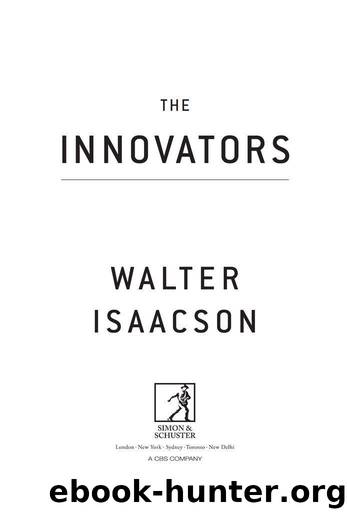The Innovators: How a Group of Inventors, Hackers, Geniuses and Geeks Created the Digital Revolution by Walter Isaacson

Author:Walter Isaacson
Language: eng
Format: mobi, epub
ISBN: 9781471138812
Publisher: Simon & Schuster UK
Published: 2014-10-06T23:00:00+00:00
THE COMMUNITY ORGANIZERS
Among the tribes of the Bay Area in the years leading up to the birth of the personal computer was a cohort of community organizers and peace activists who learned to love computers as tools for bringing power to the people. They embraced small-scale technologies, Buckminster Fuller’s Operating Manual for Spaceship Earth, and many of the tools-for-living values of the Whole Earth crowd, without being enthralled by psychedelics or repeated exposures to the Grateful Dead.
Fred Moore was an example. The son of an Army colonel stationed at the Pentagon, he had gone west to study engineering at Berkeley in 1959. Even though the U.S. military buildup in Vietnam had not begun, Moore decided to become an antiwar protestor. He camped out on the steps of Sproul Plaza, soon to become the epicenter of student demonstrations, with a sign denouncing ROTC. His protest lasted only two days (his father came to take him home), but he reenrolled at Berkeley in 1962 and resumed his rebellious ways. He served two years in jail as a draft resister and then, in 1968, moved to Palo Alto, driving down in a Volkswagen van with a baby daughter whose mother had drifted away.75
Moore planned to become an antiwar organizer there, but he discovered the computers at the Stanford Medical Center and became hooked. Since nobody ever asked him to leave, he spent his days hacking around on the computers while his daughter wandered the halls or played in the Volkswagen. He acquired a faith in the power of computers to help people take control of their lives and form communities. If they could use computers as tools for personal empowerment and learning, he believed, ordinary folks could break free of the dominance of the military-industrial establishment. “Fred was a scrawny-bearded, intense-eyed radical pacifist,” recalled Lee Felsenstein, who was part of the community organizing and computer scene in Palo Alto. “At the drop of a hat he would scurry off to pour blood on a submarine. You couldn’t really shoo him away.”76
Given his peacenik-tech passions, it is not surprising that Moore gravitated into the orbit of Stewart Brand and his Whole Earth crowd. Indeed, he ended up having a star turn at one of the weirdest events of the era: the 1971 demise party for the Whole Earth Catalog. Miraculously, the publication had ended its run with $20,000 in the bank, and Brand decided to rent the Palace of Fine Arts, an ersatz classical Greek structure in San Francisco’s Marina District, to celebrate with a thousand kindred spirits who would decide how to give away the money. He brought a stack of hundred-dollar bills, harboring a fantasy that the rock- and drug-crazed crowd would come to a judicious consensus on what to do with it. “How can we ask anyone else in the world to arrive at agreements if we can’t?” Brand asked the crowd.77
The debate lasted ten hours. Wearing a monk’s black cassock with hood, Brand let each speaker hold the stack of money while addressing the crowd, and he wrote the suggestions on a blackboard.
Download
The Innovators: How a Group of Inventors, Hackers, Geniuses and Geeks Created the Digital Revolution by Walter Isaacson.epub
This site does not store any files on its server. We only index and link to content provided by other sites. Please contact the content providers to delete copyright contents if any and email us, we'll remove relevant links or contents immediately.
| Blogging & Blogs | eBay |
| E-Commerce | Hacking |
| Online Searching | Podcasts & Webcasts |
| Search Engine Optimization | Social Media |
| Social Media for Business | Web Browsers |
| Web Marketing |
Sass and Compass in Action by Wynn Netherland Nathan Weizenbaum Chris Eppstein Brandon Mathis(7782)
Grails in Action by Glen Smith Peter Ledbrook(7697)
Secrets of the JavaScript Ninja by John Resig Bear Bibeault(6419)
Kotlin in Action by Dmitry Jemerov(5066)
WordPress Plugin Development Cookbook by Yannick Lefebvre(3806)
Mastering Azure Security by Mustafa Toroman and Tom Janetscheck(3330)
Learning React: Functional Web Development with React and Redux by Banks Alex & Porcello Eve(3088)
Mastering Bitcoin: Programming the Open Blockchain by Andreas M. Antonopoulos(2868)
The Art Of Deception by Kevin Mitnick(2606)
Drugs Unlimited by Mike Power(2467)
Kali Linux - An Ethical Hacker's Cookbook: End-to-end penetration testing solutions by Sharma Himanshu(2314)
The Innovators: How a Group of Hackers, Geniuses, and Geeks Created the Digital Revolution by Walter Isaacson(2307)
Writing for the Web: Creating Compelling Web Content Using Words, Pictures and Sound (Eva Spring's Library) by Lynda Felder(2263)
SEO 2018: Learn search engine optimization with smart internet marketing strategies by Adam Clarke(2194)
A Blueprint for Production-Ready Web Applications: Leverage industry best practices to create complete web apps with Python, TypeScript, and AWS by Dr. Philip Jones(2187)
JavaScript by Example by S Dani Akash(2138)
DarkMarket by Misha Glenny(2083)
Wireless Hacking 101 by Karina Astudillo(2078)
Full-Stack React Projects by Shama Hoque(1990)
